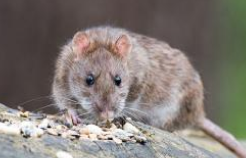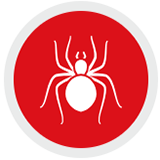Do Rodents in Washington State Carry Hantavirus?
Cases of Hantavirus have been popping up throughout the world recently, including a woman in Oregon who died in June 2018 from exposure to the virus. Four mice in San Diego County, California, tested positive for Hantavirus in January of 2018, and although no humans fell ill from those SoCal critters, recent years have seen an uptick in Hantavirus diagnoses. Yosemite National Park reported a cluster of cases in 2012. At that time,10 people were infected and three died from exposure to mice nesting in the walls of tent cabins. Last year, five people exposed to contaminated rodents in Washington State were infected and three died, the state’s worst breakout in 18 years. We’re here to educate you on Hantavirus by covering the following topics:
- What is Hantavirus
- How do you get it
- How common is it
- What are the symptoms
- What should you do if you contract it
- Tips on preventing it
What is Hantavirus?
Rodents carry a group of viruses collectively called “Hantaviruses.” The “Sin Nombre” form of the virus is found in deer mice in North America and is the cause of most Hantavirus Pulmonary Syndrome (HPS) cases in people.
How Do You Get Hantavirus?
Deer mice excrete the virus in their urine, saliva, and droppings. A person may be exposed to Hantavirus by breathing contaminated dust after disturbing or cleaning up rodent droppings or nests; by getting contaminated dust into their eyes, mouth, or nose; or by living and working in rodent-infested settings.
Pets, snakes, and predators don’t become infected and can’t spread the Hantavirus infection to people or other animals. In North America, there is no evidence that the disease (HPS) spreads from one person to another.
How Common is Hantavirus?
Four kinds of rodents are known to carry the virus, according to the Center for Disease Control & Prevention (CDC). However, only the Deer mouse is one of the more prevalent rodents in Washington State. Deer mice live in all parts of Washington but mainly in rural areas. In Washington, of more than 1,100 Deer mice tested, about 14% had the Sin Nombre form of the virus.
From the CDC.gov website: Hantavirus is more prevalent in the western United States. Beware of rodents in Washington state that may carry the virus.
Because infected Deer mice live throughout the state, human cases of Hantavirus Pulmonary Syndrome can occur in any part of Washington. Typically, one to five cases occur each year.
What Are The Symptoms of Hantavirus Pulmonary Syndrome?
According to the Washington State Department of Health, symptoms begin one to eight weeks after inhaling the virus and typically start with 3-5 days of illness including:
- Fever
- Sore muscles
- Headaches
- Nausea
- Vomiting
- Fatigue
- As the disease gets worse, it causes shortness of breath due to fluid-filled lungs.
Because of the dangerous nature of the disease, hospital care is usually required. This means it is a serious disease. About one out of three people diagnosed with HPS have died.
What Should I Do If I Think I’ve Contracted Hantavirus?
See your doctor immediately and tell your doctor about your possible rodent exposure if you come in contact with rodents or rodent-infested buildings and have symptoms. Symptoms begin one to eight weeks after exposure to the virus. It typically starts with three to five days of flu-like symptoms, including fever, sore muscles, headaches, nausea, vomiting, and fatigue. As the illness gets worse, it causes coughing and shortness of breath. About one out of three people diagnosed with HPS die, even after hospitalization.
What Should I Do To Prevent Hantavirus Pulmonary Syndrome?
Keeping rodents out of your home and workplace is a sound preventive measure against HPS and other rodent-borne pathogens. If you think you may have rodents in your home, then you should contact Eastside Exterminators right away for a rodent inspection. We highly recommend a thorough rodent inspection be done by a specialized and trained professional with the proper safety equipment.
How Should I Clean Up Rodent-Infested Areas?
- Firstly, wear rubber, latex, vinyl, or nitrile gloves.
- Wear a respirator. Note that dust mask may provide some protection against dust encountered during cleaning, but does not protect against viruses.
- Do not stir up dust by vacuuming, sweeping, or any other means.
- Next, thoroughly wet contaminated areas including trapped mice, droppings, and nests with a 10% hypochlorite (bleach) solution. Mix 1½ cups of household bleach in 1 gallon of water (or 1 part bleach to 9 parts water). After soaking everything for 10 minutes, remove all of the nest material, mice or droppings with a damp towel. Then mop or sponge the area with bleach solution.
- Steam clean or shampoo upholstered furniture and carpets with evidence of rodent exposure.
- Next, spray dead rodents with disinfectant and then double-bag along with all cleaning materials. Bury, burn, or throw out rodents in an appropriate waste disposal system.
- Then disinfect gloves with disinfectant or soap and water before taking them off.
- Finally, after taking off the clean gloves, thoroughly wash hands with soap and water (or use a waterless alcohol-based hand rub when soap is not available).
- For the safest solution, hire a trained rodent control specialist.
What Precautions Should I Use When Working, Hiking, or Camping Outdoors?
- Avoid coming into contact with rodents and rodent burrows or disturbing dens.
- Air out cabins and shelters, then check for signs of rodent infestation. Do not sweep out infested cabins. Instead, use the guidelines above for disinfecting cabins or shelters before sleeping in them.
- Do not pitch tents or place sleeping bags near rodent droppings or burrows.
- If possible, do not sleep on the bare ground. Use tents with floors or a ground cloth.
- Keep food in rodent-proof containers!
- Handle trash according to site restrictions and keep it in rodent-proof containers until disposed of.
- Most importantly, do not handle or feed wild rodents.
Trust 50+ Years of Safe, Successful Rodent Control
Eastside Exterminators has been in business since 1969 and pioneered the four-step rodent inspection and exclusion process. Our team of highly trained, licensed professionals will conduct a 27-point inspection of your home. Eastside’s structural exclusion experts use top-quality materials to create a long-lasting seal that will prevent rodents from gaining access. Trapping throughout the process removes any rodents living on the inside of the structure while the exclusion process takes place. Our ongoing Signature Service controls the outside population over time to reduce the pressure to gain entry into your home. Call us today at 425-318-7912 to schedule a rodent inspection, and protect your home.

 (425) 318-7912
(425) 318-7912
 MY ACCOUNT
MY ACCOUNT
 425-318-7912
425-318-7912








